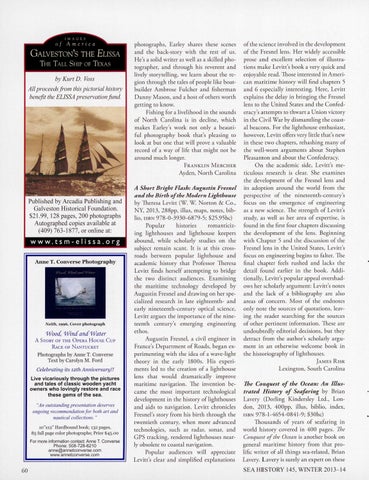I \I .\ '; L '
of
Amc:r1ca
GALVESTON'S THE ELISSA
T1 IE
T\LL
S111r
OF
Trx.c\s
by Kurt D. Voss All proceeds from this pictorial history benefit the ELISSA preservation fund.
phorographs, Earley shares these scenes and the back-story with the rest of us. He's a solid writer as well as a ski lled phorographer, and through his reverent and lively srorytelling, we learn about the region rhrough the tales of people like boatbuilder Ambrose Fulcher and fisherman Danny Mason, and a hosr of orhers worth getting ro know. Fishing for a livelihood in the sounds of North Carolina is in decline, which makes Earley's work not only a beautifu l phorography book rhar's pleasing ro look at but one rhar will prove a valuable record of a way of life rhar mighr nor be aro und much longer. FRANKLIN M ERCHER
Ayden, North Carolin a
Published by Arcadia Publishing and Galveston Historical Foundation. $2 1.99, 128 pages, 200 photographs Autographed copies available at (409) 763-18 77, or online at:
www.tsm-elissa.org Ann e T. Converse Phot ography
Neith, 1996, Cover photograph
Wood; Wina antf Water A S TO RY OF T H E O
PERA H ousE Cur
RACE OF NANTUCKET
Photographs by Anne T. Converse Text by Carolyn M. Ford Celebrating its 12th A nniversary!! Live vicariously through the pictures and tales of classic wooden yacht owners who lovingly restore and race these gems of the sea. "An outstanding presentation deserves ongoing recommendation for both art and nautical collections. " 10"x 12 " Hardbound book; 132 pages, 85 full page color photographs; Price $45.00
For more information contact: Anne T. Converse Phone : 508-728-621 O anne@annetconverse.com www.annetconverse.com
60
A Short Bright Flash: Augustin Fresnel and the Birth ofthe Modern Lighthouse by Theresa Levitt (W. W. Narro n & Co., NY, 201 3, 288pp, illus, maps, nores, biblio, ISB N 978-0-3930-6879-5; $25.95hc) Popular hisrories romam1ozing lighthouses and lighthouse keepers abound, while scholarly srudies on rhe subject remain scam. Ir is at this crossroads between popular lighthouse and academic hisrory rhat Professor Theresa Levitt finds herself attempting ro bridge the two distinct audiences. Examining rhe maritime technology developed by Augustin Fresnel and drawing on her specialized research in late eighteenth- and early nineteenth-century optical science, Levitt argues the importance of the nineteenth century's emerging engineering ethos. Augusti n Fresnel, a civil engineer in France's Department of Roads, began experimenting with the idea of a wave-lighr theory in the early 1800s. His experiments led ro the creation of a lighthouse lens that would dramatically improve maritime navigation. The invention became rhe most important technological development in the hisrory of lighthouses and aids to navigation. Levitt chronicles Fresnel's srory from his birth through the twentieth century, when more advanced technologies, such as radar, son ar, and GPS tracking, rendered lighthouses nearly obsolere ro coastal navigation. Popular audiences will appreciate Levitt's clear and simplified explanations
of the science involved in the development of the Fresnel lens. Her widely accessible prose and excellent selection of illustrations make Levitt's book a very quick and enjoyable read. Those interested in American maritime hisrory will find chapters 5 and 6 especially interesting. Here, Levitt explains the delay in bringing rhe Fresnel lens ro the United States and the Confederacy's attempts to thwart a Union vicrory in the Civil War by dismantling the coastal beacons . For the lighthouse enthusiast, however, Levitt offers very little that's new in these two chapters, rehashing many of rhe well-worn arguments about Stephen Pleasanton and about the Confederacy. On the academic side, Levitt's meticulous research is clear. She examines the development of the Fresnel lens and irs adoption around the world from rhe perspective of rhe ninereemh-century's focus on the emergence of engineering as a new science. The strength of Levitt's srudy, as well as her area of expertise, is found in the first four chapters discussing the development of the lens. Beginning wirh Chapter 5 and the discussion of the Fresnel lens in the United States, Levitt's focus on engineering begins ro falter. The final ch apter feels rushed and lacks the derail found earlier in rhe book. Additionally, Levitt's popular appeal overshadows her scholarly arg ument: Levitt's notes and the lack of a bibliography are also areas of concern . Most of the endnotes only note the sources of quotations, leaving the reader searching for the sources of other p ertinent information. These are undoubtedly edirorial decisions, but they detract from rhe author's scholarly argument in an otherwise welcome book in rhe historiography of lighthouses. ] AMES RI SK
Lexington, South Carolina
The Conquest of the Ocean: An Illustrated History of Seafaring by Brian Lavery (Darling Kindersley Ltd., London , 2013, 400pp, illus, biblio, index, ISBN 978-1-4654-0841-9; $3 0hc) Thousands of years of seafaring in world hisrory covered in 400 pages . The Conquest of the Ocean is another book on general maritime h istory from that prolific writer of all things sea-related, Brian Lavery. Lavery is surely an expert on these SEAHilSTORY 145, WINTER 2013-14
